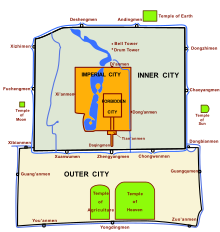Beijing City Walls
The city walls of Beijing were one of the most impressive preserved city fortifications in the world until the middle of the 20th century. Since then (until 1978) they have been largely eliminated and replaced by the 2nd ring road .
history
The original wall wreath around the old town was built under the Mongolian ( yuan . The Ming that followed it also remained with Beijing as its capital. The northern part of the city wall was moved about 2.5 km to the south, the southern part by only 1 km - Beijing As Beijing was also the capital of the last dynasty of the Chinese Empire, namely the Manchurian Qing ), the fortifications took on a monumental character. The wall was 20 m wide at the base and 12 m at the top, and its height was 12 meters. There were 9 gates around the old city center, three of which are still preserved: the Desheng Gate , the Yongding Gate (reconstructed in 2004) and the Zhengyang Gate . There were also 7 gates around the Neustadt, which was incorporated in 1553.
As early as 1900 during the Boxer Rebellion , parts of the city fortifications of Beijing were destroyed or damaged by insurgents or foreign troops. Between 1911 and 1949 there were only minor, traffic-related breakthroughs. The building was, however, in a generally poor condition. In the early years of the communist regime there were still relatively open debates about preservation or demolition. In particular, the internationally known Chinese architectural historian and city planner Liang Sicheng (1901–1972) campaigned for the preservation of the unique building. After the end of the Hundred Flowers Movement , however, the dictatorship hardened and there were large-scale demolitions in the course of the creation of the Beijing subway and the Second Ring Road. The city moat was vaulted over for sewer purposes. In 1979 the demolition of the city fortifications was stopped. Only a small piece of the wall has been preserved, about 400 meters from what was once about 40 km. These remains were rediscovered in 1996 when the adjacent residential area was demolished, which made it possible to remove this part of the old city wall, as it were. The residents are said to have donated old bricks for reconstruction themselves. The reconstructed parts of the Beijing city wall are located in a "Mauerdenkmal-Park" opened in 2003 in the southeast of the old town, south of the main train station. There you can also see the only surviving corner tower of the wall. Other parts of the city wall can be found east of the main train station at Beijing Station East Street and at the old observatory .
literature
- Margarete Schütte-Lihotzky : China's megacities. Springer, Vienna / New York 2007, ISBN 978-3-211-71583-3 .





